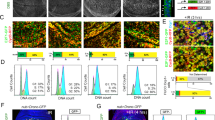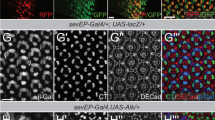Abstract
The lats gene encodes a family of proteins conserved from insects to humans. Drosophila carrying lats mutant cells or mice deficient for Lats1 develop tumors in various tissues. The mammalian LATS1 protein was previously shown to bind to CDC2, suggesting that LATS1 may modulate G2/M cell cycle progression by affecting CDC2 activity. In this study, we introduced human LATS1 into LATS−/− MEF cells by adenovirus-mediated gene transfer. Overexpression of LATS1 causes G2/M arrest through inhibition of CDC2 kinase activity. Furthermore, overexpression of LATS1 significantly suppressed the human tumor cell growth in vitro and tumorigenicity in vivo by inducing either cell cycle arrest in G2/M or apoptosis. These observations suggest that LATS1 is a potent growth suppressor and, like other tumor suppressors, it suppresses growth by inducing cell cycle arrest or apoptosis.
This is a preview of subscription content, access via your institution
Access options
Subscribe to this journal
Receive 50 print issues and online access
$259.00 per year
only $5.18 per issue
Buy this article
- Purchase on Springer Link
- Instant access to full article PDF
Prices may be subject to local taxes which are calculated during checkout





Similar content being viewed by others
References
Agarwal ML, Agarwal A, Taylor WR, Stark GR . 1995 Natl. Acad. Sci. USA 92: 8493–8497
Chan TA, Hermeking H, Lengauer C, Kinzler KW, Vogelstein B . 1999 Nature 401: 616–620
Di Cristofano A, Pandolfi PP . 2000 Cell 100: 387–390
El-Deiry WS, Tokino T, Velculescu VE, Levy DB, Parsons R, Trent JM, Lin D, Mercer WE, Kinzler KW, Vogelstein B . 1993 Cell 75: 817–825
Elledge SJ . 1996 Science 274: 1664–1672
Harbour JW, Dean DC . 2000 Nat. Cell Biol. 2: E65–E67
He L, Yu JX, Liu L, Buyse IM, Wang MS, Yang QC, Nakagawara A, Brodeur GM, Shi YE, Huang S . 1998 Cancer Res. 58: 4238–4244
Hermeking H, Lengauer C, Polyak K, He TC, Zhang L, Thiagalingam S, Kinzler KW, Vogelstein B . 1997 Mol. Cell 1: 3–11
Innocente SA, Abrahamson JL, Cogswell JP, Lee JM . 1999 Proc. Natl. Acad. Sci. USA 96: 2147–2152
Kataoka M, Wiehle S, Spitz F, Schumacher G, Roth JA, Cristiano RJ . 2000 Oncogene 19: 1589–1595
Levine AJ . 1997 Cell 88: 323–331
MacLachlan TK, Somasundaram K, Sgagias M, Shifman Y, Muschel RJ, Cowan KH, El-Deiry WS . 2000 J. Biol. Chem. 275: 2777–2785
Oda K, Arakawa H, Tanaka T, Matsuda K, Tanikawa C, Mori T, Nishimori H, Tamai K, Tokino T, Nakamura Y, Taya Y . 2000 Cell 102: 849–862
Quelle DE, Ashmun RA, Hannon GJ, Rehberger PA, Trono D, Richter KH, Walker C, Beach D, Sherr CJ, Serrano M . 1995 Oncogene 11: 635–645
St John MA, Tao W, Fei X, Fukumoto R, Carcangiu ML, Brownstein DG, Parlow AF, McGrath J, Xu T . 1999 Nat. Genet. 21: 182–186
Tao W, Zhang S, Turenchalk GS, Stewart RA, St John MAR, Chen W, Xu T . 1999 Nat. Genet. 21: 177–181
Wang XW, Zhan Q, Coursen JD, Khan MA, Kontny HU, Yu L, Hollander MC, O'Connor PM, Fornace AJ, Harris Jr CC . 1999 Proc. Natl. Acad. Sci. USA 96: 3706–3711
Wechsler DS, Shelly CA, Petroff CA, Dang CV . 1997 Cancer Res. 57: 4905–4912
Xu T, Wang W, Zhang S, Stewart RA, Yu W . 1995 Development 121: 1053–1063
Yabuta N, Fujii T, Copeland NG, Gilbert DJ, Jenkins NA, Nishiguchi H, Endo Y, Toji S, Tanaka H, Nishimune Y, Nojima H . 2000 Genomics 63: 263–270
Yang X, Jin G, Nakao Y, Rahimtula M, Pater MM, Pater A . 1996 Int. J. Cancer 65: 338–344
Yang X, Chernenko G, Hao Y, Ding Z, Pater MM, Pater A, Tang SC . 1998 Oncogene 17: 981–989
Yang X, Hao Y, Ding Z, Pater A . 2000 Exp. Cell Res. 256: 491–499
Zhan Q, Antinore MJ, Wang XW, Carrier F, Smith ML, Harris CC, Fornace Jr AJ . 1999 Oncogene 18: 2892–2900
Acknowledgements
We thank Y Hao and K Sepaneck for assistance, Dr A Pater for reading the manuscript, Dr A Pater and G Chernenko at Memorial University of Newfoudland, Canada, and Dr H Sun at Yale University for kindly providing human cancer cell lines, and R Carbone at the Yale Cancer Center Flow Cytometry Shared Resource for FACS measurement and data analysis. Xiaolong Yang is an Anna Fuller Fellow and a recipient of the Medical Research Council of Canada Fellowships.
Author information
Authors and Affiliations
Corresponding author
Rights and permissions
About this article
Cite this article
Yang, X., Li, Dm., Chen, W. et al. Human homologue of Drosophila lats, LATS1, negatively regulate growth by inducing G2/M arrest or apoptosis. Oncogene 20, 6516–6523 (2001). https://doi.org/10.1038/sj.onc.1204817
Received:
Revised:
Accepted:
Published:
Issue Date:
DOI: https://doi.org/10.1038/sj.onc.1204817
Keywords
This article is cited by
-
Utilizing the Hippo pathway as a therapeutic target for combating endocrine-resistant breast cancer
Cancer Cell International (2021)
-
SUMOylation activates large tumour suppressor 1 to maintain the tissue homeostasis during Hippo signalling
Oncogene (2021)
-
Molecular Alterations and Expression Dynamics of LATS1 and LATS2 Genes in Non-Small-Cell Lung Carcinoma
Pathology & Oncology Research (2018)
-
The LATS1 and LATS2 tumor suppressors: beyond the Hippo pathway
Cell Death & Differentiation (2017)
-
Photoreceptor proliferation and dysregulation of cell cycle genes in early onset inherited retinal degenerations
BMC Genomics (2016)



